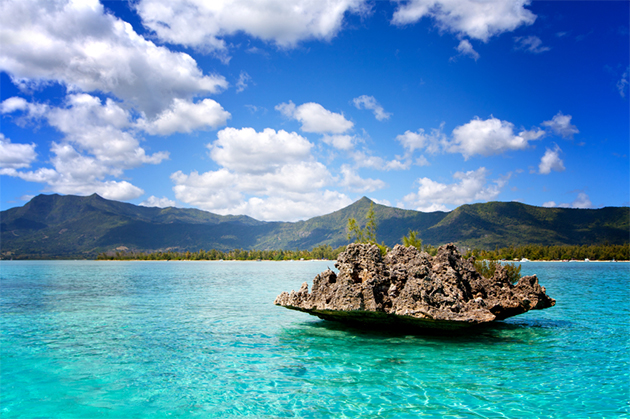
When you think of an island destination, you might conjure images of rustling palm trees and umbrella drinks. And you’d be half right. However, there are so many travel-worthy islands around the world hardly explored by travelers who opt for easier, more developed beachfront resorts. These islands offer escapes from bustling resort towns, plus access to untouched natural environments and a cultural experience like no other. Here are the five island destinations worth booking this spring and summer:
The 15 islands that make up the Cook archipelago might just be the best-kept secret in the South Pacific. Seasonal weather varies oh-so-slightly, ranging between 65 and 85 degrees all year long, making for ideal conditions to explore this pristine collection of islands. Trek through the 385-acre Takitumu Conservation Area on the main island of Rarotonga, where you can see about 70 percent of all the plant species found on the islands and native birds such as the rupe (Pacific pigeon), the kukupa (fruit dove) and the I‘oi (Rarotonga starling). Or dive off the coast of Aitutaki (an island north of Rarotonga) and swim with giant turtles and eagle rays and feed fish coconuts right from your hand. Check out the local cuisine as well, such as curried eke (octopus in coconut curry), ika mata (raw fish in coconut milk) and rukau (taro leaves usually cooked in coconut cream). The local microbrewery in Rarotonga, Matutu Brewery Company, is worth checking out, too.
Where to stay
If you want to experience daily life in the Cook Islands, consider Atiu Guesthouse on Atiu, the third largest island in the archipelago. This was a family home that was converted into a bed and breakfast for travelers. There’s no air conditioning or cable TV, but the rooms are outfitted with mosquito screens and fans. There’s also a kitchen stocked with fresh fruits and local coffee, a palm-frond thatched veranda and lots of time to sit back and relax.
Lanai, Hawaii
There are no traffic lights, no shopping malls and no public transit on this island, the sixth-largest of the Hawaiian Islands. Now a tourist destination with luxe resorts and two world-class golf courses, Lanai was once almost entirely a pineapple plantation. It’s the smallest inhabited island in Hawaii with about 3,000 residents and a scant 30 miles of paved road. And though it’s small — just 140 square miles —there’s surprisingly a lot to do, from watching migrating humpback whales from the two-mile stretch of Polihua Beach to hiking along the 12.8-mile Munro Trail lined with Cook pine trees and offering sweeping views Maunalei Gulch and the Pacific Ocean.
Where to stay
Finding luxury accommodations on Lanai won’t be a problem, as the island is home to two Forbes Travel Guide Four-Star hotels — Four Seasons Resort Lana’i at Manele Bay and Four Seasons Resort Lana’i, The Lodge at Koele. The Manele Bay beachfront property is poised atop red lava cliffs and oozes a Mediterranean villa vibe, while The Lodge at Koele can be found in the center of Lanai and provides a more Victorian-style atmosphere.
Robben Island, South Africa
This flat, oval-shaped island in Table Bay off the coast of South Africa may not seem like a tourist destination, but its place in history — late South African leader Nelson Mandela was imprisoned here for 18 of the 27 years he served behind bars before the fall of apartheid — has made it a hot spot for folks interested in African history and culture. In 1999, the island was declared a UNESCO World Heritage Site and can only be reached by ferry from the Victoria & Alfred Waterfront in Cape Town. You can tour the austere maximum-security prison led by guides who were former inmates or visit the 59-foot-tall Robben Island lighthouse on Fire Hill, the highest point on the island.
Where to stay
Since Robben Island isn’t outfitted with hotels and resorts, stay on the 114-foot luxury super yacht, Kiara, which is moored at the V&A Waterfront. It boasts four cabins with laundry facilities and Wi-Fi, and is equipped with two Yamaha Waverunners complete with water skis and a kneeboard to play out on the water.
Kosrae, Federated States of Micronesia
If you’re looking for unspoiled landscapes and pristine oceans, Kosrae, the easternmost of the Caroline Islands between Guam and Hawaii, should be high on your bucket list. This largely untouched island, with miles of vibrant coral reefs and undeveloped mountains, has become a haven for divers and hikers. Walk through the Wiya Bird Cave in Tafunsak, located about two miles from the Kosrae International Airport, and walk through a cave once thought to house giants that’s now home to thousands of Island Swiftlets. You can also relax in the bath pool at the bottom of the 30-foot cascading Sipyen Waterfall in Utwe, or visit the Giant Clam Farm in the Lelu Causeway, where giant clams can reach up to three feet across and weigh more than 1,000 pounds.
Where to stay
There are only six hotels dotting the coastline here, with a total of 60 rooms. Accommodations are more rustic, not luxurious. Consider staying at the Pacific Treelodge, which boasts six beachside wooden cottages amid mangrove trees and perched on the water’s edge, complete with air conditioning, cable TV and Wi-Fi. You can walk to its popular restaurant, Bully’s, along the lodge’s wooden or recycled glass bridge or visit the only Terminalia carolinensis (a tree native to the area) forest in the world.
Mauritius, Indian Ocean
The most developed of the Mascarene Islands, Mauritius has long been a playground for wealthy Europeans and celebrities, outfitted with megaresorts and über-chic accommodations. But though this luxury destination may be best known for its cobalt-blue seas and sugary sand beaches that seem to stretch on forever, it’s also home to some of the world’s rarest plants and animals. (Its claim to fame is being the only home of the now-extinct Dodo bird.) There are more than 700 species of indigenous plants on the island (including the Trochetia Boutoniana, the national flower), many of which are threatened with extinction. And its waters are teeming with marine life, from moray eels to multicolored fish. Less than two percent of the native forest that once stretched from the mountains of the central plateau to the shoreline now remains, but you can visit the Black River Gorges National Park, which sprawls over miles of upland and lowland forests, lush rainforest and marshy heathland on the island’s southwestern end. There are more than 37 miles of trails twisting through this national park, which preserves native wildlife such as the Mauritian flying fox, a fruit bat endemic to the island and several indigenous birds.
Where to stay
Appropriate for its jet-setting visitors, Mauritius is no stranger to top-notch resorts. Luxe hotels run the gamut from the Four Seasons Resort Mauritius at Anahita to The Oberoi, Mauritius and Le Touessrok. With plenty of places to choose from, you really can’t go wrong.
Photos Courtesy of iStock and Peter Vitale


